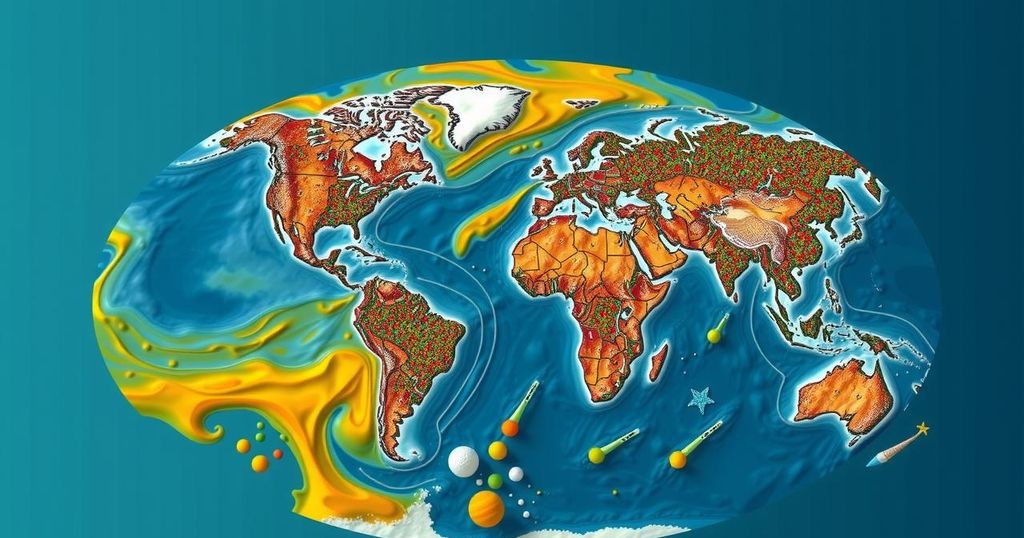Modeling experiments reveal that the El Niño oscillation has existed for at least 250 million years, often with greater intensity compared to modern times. Conducted by researchers at Duke University, this study underscores the significance of both ocean thermal dynamics and atmospheric winds in shaping climate patterns, calling for a comprehensive understanding of historical climates to better predict future changes.
Recent modeling experiments conducted by researchers at Duke University have revealed that the El Niño phenomenon, characterized by significant warming of ocean waters in the tropical Pacific Ocean, is not merely a contemporary occurrence. The findings indicate that the oscillation known as El Niño, along with its counterpart, La Niña, has been present for at least 250 million years, often exhibiting greater intensity than what is currently observed. The study, published on October 21 in the Proceedings of the National Academy of Sciences, reflects upon how temperature fluctuations in Earth’s distant past were more pronounced, occurring even when the continents were situated differently than today. Shineng Hu, an assistant professor of climate dynamics at Duke University’s Nicholas School of the Environment, stated, “In each experiment, we see active El Niño Southern Oscillation, and it’s almost all stronger than what we have now, some way stronger, some slightly stronger.” The research utilized advanced climate modeling techniques, akin to those employed by the Intergovernmental Panel on Climate Change (IPCC), but inverted the application to analyze historical climate data over elongated periods. Due to the computational demands, the researchers executed simulations in 10-million-year increments, examining 26 distinct segments of time. Variations in boundary conditions, including geographical land-sea distributions, solar radiation levels, and atmospheric CO2 concentrations, were integral to their analysis. The results demonstrated that despite a 2% reduction in solar radiation during certain epochs, there existed a far more significant concentration of CO2, contributing to a markedly warmer atmosphere and ocean environment compared to present-day conditions. The study specifically highlights that the ocean’s thermal structure and the atmospheric winds, referred to as “atmospheric noise,” play vital roles in the magnitude of the oscillation historically observed. Hu emphasizes the need for a balanced understanding of both oceanic and atmospheric influences, noting, “Besides ocean thermal structure, we need to pay attention to atmospheric noise as well and to understand how those winds are going to change.” He further likens the dynamics of this oscillation to a pendulum negatively affected by random impulses from winds, signifying that both elements are crucial for comprehending the strength of historical El Niño events. Hu concluded that understanding the past climate dynamics is essential for reliable future projections of climate behavior, asserting, “If we want to have a more reliable future projection, we need to understand past climates first.”
The El Niño phenomenon represents a significant climate oscillation associated with temperature variations in the tropical Pacific Ocean, which have extensive impacts on global weather patterns. The oscillation alternates between warm (El Niño) and cool (La Niña) phases. This study provides new insights into the historical context of these occurrences, suggesting their existence for hundreds of millions of years, thereby influencing various climate systems and ecological conditions throughout geological history. Understanding these patterns offers crucial context for current climate models and future predictions.
The recent modeling studies conducted by Duke University researchers indicate that the El Niño oscillation has persisted for at least 250 million years, often exhibiting greater intensity than observed today. It illustrates the importance of examining historical climatic variables, such as ocean temperature and atmospheric winds, which play significant roles in understanding the behavior of these oscillations. Recognizing the long-term patterns of El Niño and La Niña is essential for improving the accuracy of future climate projections, as emphasized by researcher Shineng Hu.
Original Source: phys.org






